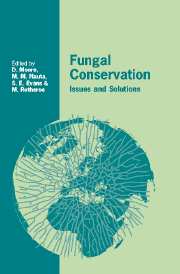Book contents
- Frontmatter
- Contents
- List of contributors
- Preface
- 1 Fungal conservation issues: recognising the problem, finding solutions
- 2 Current trends and perspectives for the global conservation of fungi
- 3 Conservation and management of forest fungi in the Pacific Northwestern United States: an integrated ecosystem approach
- 4 The future of fungi in Europe: threats, conservation and management
- 5 Fungi as indicators of primeval and old-growth forests deserving protection
- 6 Recognising and managing mycologically valuable sites in The Netherlands
- 7 Threats to hypogeous fungi
- 8 Wild mushrooms and rural economies
- 9 Threats to biodiversity caused by traditional mushroom cultivation technology in China
- 10 A preliminary survey of waxcap grassland indicator species in South Wales
- 11 Grasslands in the coastal dunes: the effect of nature management on the mycota
- 12 The conservation of fungi on reserves managed by the Royal Society for the Protection of Birds (RSPB)
- 13 Strategies for conservation of fungi in the Madonie Park, North Sicily
- 14 Fungal conservation in Ukraine
- 15 The threatened and near-threatened Aphyllophorales of Finland
- 16 Fungal conservation in Cuba
- 17 Microfungus diversity and the conservation agenda in Kenya
- 18 Fungi and the UK Biodiversity Action Plan: the process explained
- 19 The Scottish Wild Mushroom Forum
- 20 The contribution of national mycological societies: establishing a British Mycological Society policy
- 21 The contribution of national mycological societies: the Dutch Mycological Society and its Committee for Fungi and Nature Conservation
- 22 Fungal conservation in the 21st century: optimism and pessimism for the future
- Index
Preface
Published online by Cambridge University Press: 13 October 2009
- Frontmatter
- Contents
- List of contributors
- Preface
- 1 Fungal conservation issues: recognising the problem, finding solutions
- 2 Current trends and perspectives for the global conservation of fungi
- 3 Conservation and management of forest fungi in the Pacific Northwestern United States: an integrated ecosystem approach
- 4 The future of fungi in Europe: threats, conservation and management
- 5 Fungi as indicators of primeval and old-growth forests deserving protection
- 6 Recognising and managing mycologically valuable sites in The Netherlands
- 7 Threats to hypogeous fungi
- 8 Wild mushrooms and rural economies
- 9 Threats to biodiversity caused by traditional mushroom cultivation technology in China
- 10 A preliminary survey of waxcap grassland indicator species in South Wales
- 11 Grasslands in the coastal dunes: the effect of nature management on the mycota
- 12 The conservation of fungi on reserves managed by the Royal Society for the Protection of Birds (RSPB)
- 13 Strategies for conservation of fungi in the Madonie Park, North Sicily
- 14 Fungal conservation in Ukraine
- 15 The threatened and near-threatened Aphyllophorales of Finland
- 16 Fungal conservation in Cuba
- 17 Microfungus diversity and the conservation agenda in Kenya
- 18 Fungi and the UK Biodiversity Action Plan: the process explained
- 19 The Scottish Wild Mushroom Forum
- 20 The contribution of national mycological societies: establishing a British Mycological Society policy
- 21 The contribution of national mycological societies: the Dutch Mycological Society and its Committee for Fungi and Nature Conservation
- 22 Fungal conservation in the 21st century: optimism and pessimism for the future
- Index
Summary
Conservation is a major concern at the moment. In the second half of the twentieth century, naturalists (including mycologists) became aware of a general decline in natural habitats. Significant decline in the number of species, and in the occurrence of species of fungi, was detected in the 1960s in several countries in Europe and was correlated with changes in land usage and with three consistent themes of environmental pollution: eutrophication (contamination of water bodies with nutrients draining off agricultural land), acid rain (mostly downwind of industrial smoke plumes) and desertification (caused by shifts in precipitation patterns resulting from climatic change). Since that time the general attitude has changed to one in which managers try to improve biodiversity.
This book examines the various problems associated with fungal conservation. In different parts of the world there are several threats to fungi and fungal diversity that prompt thoughts of conservation. However, it is not self-evident whether and how fungi themselves can be conserved. Perhaps the emphasis should be placed on conservation of the site, or the habitat, or the host? All of these issues are addressed and debated here, but this book goes beyond mere debate by filling the need for practical guidance for management of nature in ways beneficial to fungi. Different parts of the world experience different problems, so there are different solutions too.
- Type
- Chapter
- Information
- Fungal ConservationIssues and Solutions, pp. ix - xPublisher: Cambridge University PressPrint publication year: 2001
- 1
- Cited by



